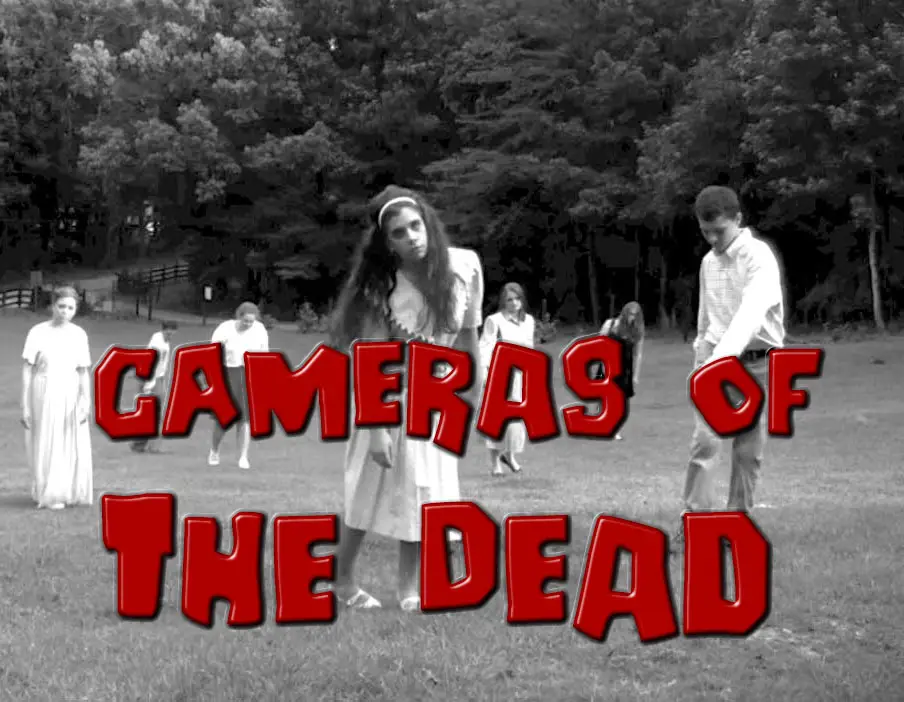 This review is part of the Cameras of the Dead series which I have been publishing every year on Halloween and “Halfway to” Halloween, featuring three cameras that I’ve wanted to review that either didn’t work, or was otherwise unable to shoot.
This review is part of the Cameras of the Dead series which I have been publishing every year on Halloween and “Halfway to” Halloween, featuring three cameras that I’ve wanted to review that either didn’t work, or was otherwise unable to shoot.
I am republishing each of those individual reviews this October in anticipation of this Halloween’s Cameras of the Dead post as a way to revisit the cameras of the past that allows them to be properly indexed on the site.
This is a Ricoh R1 compact 35mm camera made by the Ricoh Camera Company starting in 1994. It was a ‘premium’ compact 35mm camera with an innovative panoramic feature that changed the focal length of the fixed 4-element 30mm lens to 24mm when in that mode. There were two variants called the R1s and R1e, the first of which had different cosmetics and an improved lens, and the second which removed the panoramic feature. Although an unrelated camera, it is often seen as the little brother to the top of the line Ricoh GR1.
Film Type: 135 (35mm)
Lens: 30mm / 24mm f/3.5 Ricoh Lens Coated 4-elements
Focus: 14 Inches to Infinity
Viewfinder: Reverse Galilean w/ Focus Confirmation Readout
Shutter: Programmed Electronic Shutter
Speeds: 2 – 1/400 seconds, Stepless
Exposure Meter: Dual Silicon Photo Diode with Programmed Auto Exposure
Battery: CR2 3v Lithium Battery
Flash: In-Body Electronic Flash w/ Red Eye Reduction and other modes
Weight: 140 grams (no battery)
Manual: http://www.butkus.org/chinon/ricoh/ricoh_r1/ricoh_r1_scan.pdf
My Thoughts
 Throughout the camera world, there are a number of oxymorons that often get used to describe certain models. “Poor Man’s Leica” is one of my favorites. Such a camera doesn’t exist, because Leica never made cameras for “poor people” and if there was a camera that someone who was poor could afford, it wouldn’t be a Leica.
Throughout the camera world, there are a number of oxymorons that often get used to describe certain models. “Poor Man’s Leica” is one of my favorites. Such a camera doesn’t exist, because Leica never made cameras for “poor people” and if there was a camera that someone who was poor could afford, it wouldn’t be a Leica.
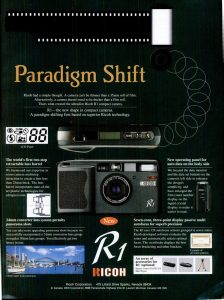
Another favorite of mine is the term “fast zoom lens”. Due to the complexity of their design, zooms are never fast. Yes, there are some like the Sigma 50-100 f/1.8 DC HSM Art lens, but it cheats somewhat by being an APS-C lens, and can’t cover a full 35mm frame. Plus, the lens costs over $1100 and it’s 2x range is rather limited at best. The fastest you’ll typically see for practical zooms is in the f/2.8 range which is “fast for a zoom” but still not “fast”.
But this article isn’t about a Poor Man’s Leica or a Fast Zoom it’s about a camera that is often labeled with another oxymoron, the “premium compact”. Originally selling for $299 in 1995 when it was first introduced, that price compares to about $500 today making it quite an investment for the typical point and shoot customer.
With the R1, Ricoh entered into the low end of the premium compact segment (should I call it a ‘poor man’s premium compact’?) with a sleek and compact body, a 4-element 30mm lens, full programmed auto exposure, seven zone auto focus system, flexible 2 to 1/500 second shutter, and a sleek 24mm wide angle panoramic mode using what Ricoh called a ‘conversion lens group’.
Panoramic photos were a bit of a fad in the mid to late 90s with nearly every manufacturer incorporating some form of panoramic modes in their models. Most cameras, like the Nikon AF600 used nothing more than a mask that would swing into position masking off the top and bottom of the 24x36mm frame creating a ‘cropped’ 18x36mm image. Minolta created a camera called the Riva Panorama that had a permanent panoramic mask but included a fixed wide angle 24mm lens to improve the panoramic effect. Ricoh simply combined the two methods, with a movable panoramic mask and a lens that could “widen” to 24mm when needed.

The Ricoh R1 was certainly a good looking camera with a neat feature set that was well worth the asking price to buy one, and of course, there are certainly examples of much more expensive premium compacts out there, such as Ricoh’s own GR1, the Contax T-series, and the Nikon 28Ti.
As impressive as many of these models are, they all have the same weakness…electronics. Each of these cameras were produced in an era with increasing amounts of technology in them. Circuit boards with electronic sensors and CPUs were replacing mechanical gears and levers. Lightweight materials such as plastic and rubber replaced metals like brass and chrome. Cameras got smaller and lighter, but they also became less tolerant of variances in temperature or physical bumps and small drops. There’s an old joke about someone who accidentally dropped an Argus C3 on the floor and another person asks, “is the floor ok?” Drop a plastic camera like the Ricoh R1 on the floor and it likely won’t ever work again.

When it comes to the “premium” label given to cameras like the Ricoh R1 and when celebrities like Kendall Jenner or Chris Hemsworth promote a camera like the Contax T2 and prices go through the roof, it is really important to remember that no matter how much money you spend on a camera like this, the chances for it to not work, or have problems is extremely high.
Which brings me to this Ricoh R1. This is a very neat camera. I loved it’s looks and it’s compact size. At 140 grams, it is very lightweight, but the body is sturdy and doesn’t creak in your hands. It fits easily into a shirt pocket and with it’s reputation of having a great semi-wide angle lens, I could see this being a go-to “zoo” camera that I used for spontaneous family photos.
This camera came to me in excellent condition and in it’s original packaging with the manual, some stickers that you’re supposed to include with film when having it processed, and even a warranty card. I had really high hopes for it, but upon inserting some batteries into the camera, other than a constant winding of the film advance, nothing happened. The LCD wouldn’t light up. The front lens never extended out of the camera. Nothing showed up in the viewfinder. It was dead.
The worst part about a dead electronic camera is that there’s almost nothing you can do about it. Maybe cleaning the battery contacts might help if there is corrosion or some other debris in the battery chamber, but that’s about it. There’s no amount of naphtha oil that will help and the best precision screwdrivers and lens spanners are useless. If the electronics are dead, the camera is simply never going to work again. Even if there was some electronic circuit that could be replaced, the parts would usually need to come from another working camera, and if you had a working camera, why not just use that?
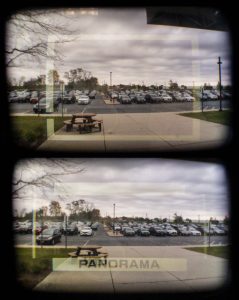
After fiddling with the camera for a brief while, I actually got the viewfinder to sort of work and I was able to get a glimpse into what shooting the R1 might have been like. The viewfinder uses some type of projected bright lines using LCD technology that can change the framing of the image depending on whether you are in Panoramic mode or not.
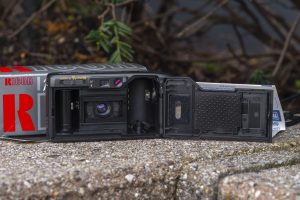
Like many other 1990s point and shoot cameras with a Panoramic mode, the camera uses a mask in the film compartment that covers up part of the 24x36mm frame, but unlike those cameras, the R1 also widens the focal length of the lens from 30mm to 24mm, increasing the amount of image that fits into the smaller 18x36mm frame. I believe this is accomplished via an extra lens element that swings into position within the camera body, acting like a correction filter, but since I couldn’t actually use the camera, I can’t be sure.
There is an awful lot to like about the Ricoh R1. I don’t know if the pictures adequately portray how compact and nice this camera is to hold. The form factor of this camera is excellent. The feature set is quite competitive with other mid priced point and shoot cameras of the 1990s, and although I never got to shoot any film through it, Ricoh lenses generally receive positive praise, so I’m sure I would have gotten great photographs from it.
But that’s not what happened. I am sure there are many other R1s out there just like this one. Dead.
Related Posts You Might Enjoy
External Links
http://camera-wiki.org/wiki/Ricoh_R1
https://kenrockwell.com/tech/ricoh/r1.htm
https://www.35mmc.com/12/02/2016/ricoh-r1-rollei-prego-micron/
https://vintagecameralab.com/ricoh-r1/
https://www.lomography.com/magazine/34968-the-ricoh-r1-a-wide-angle-wonder

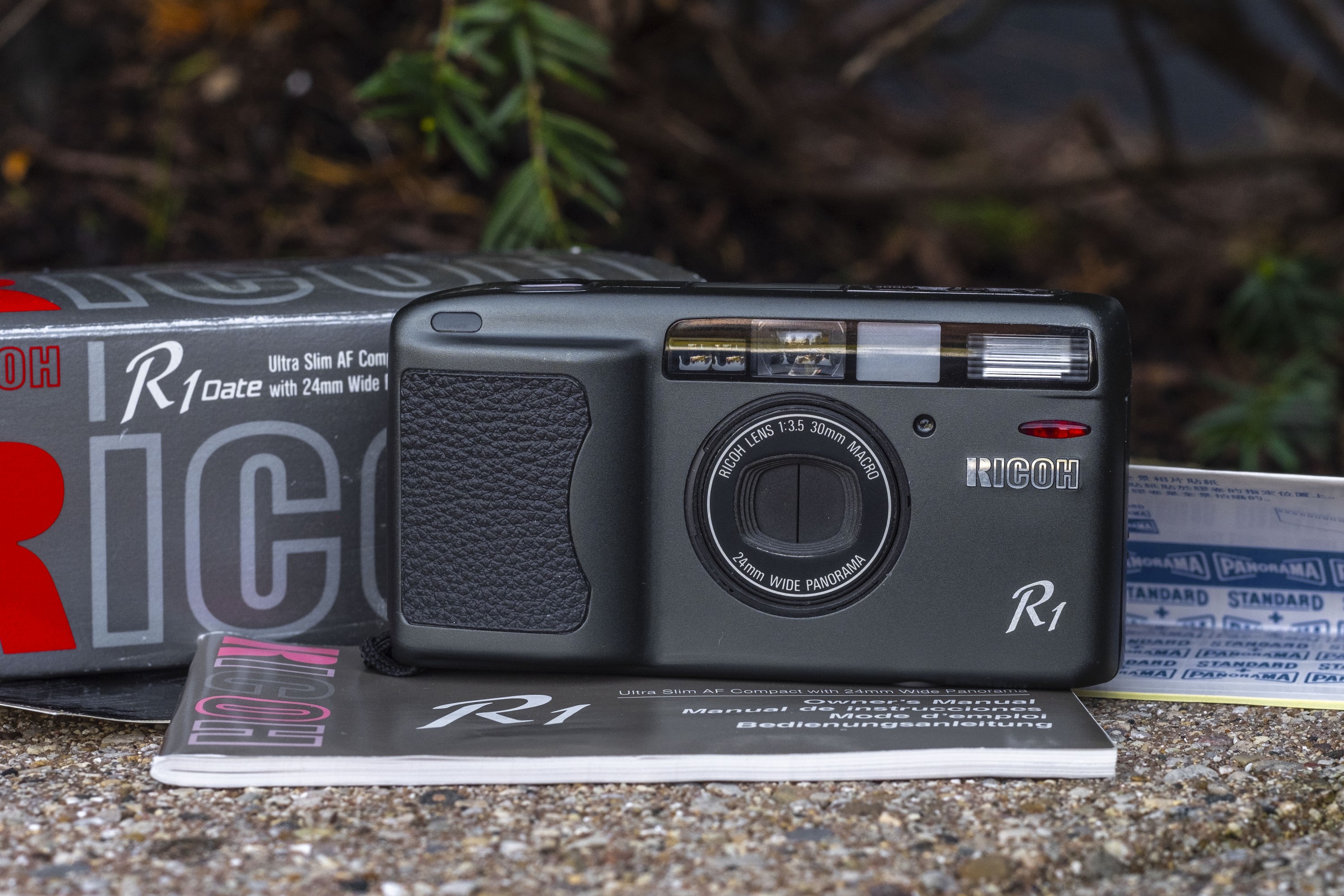
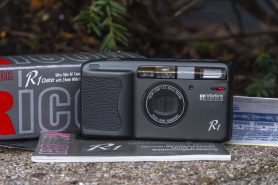
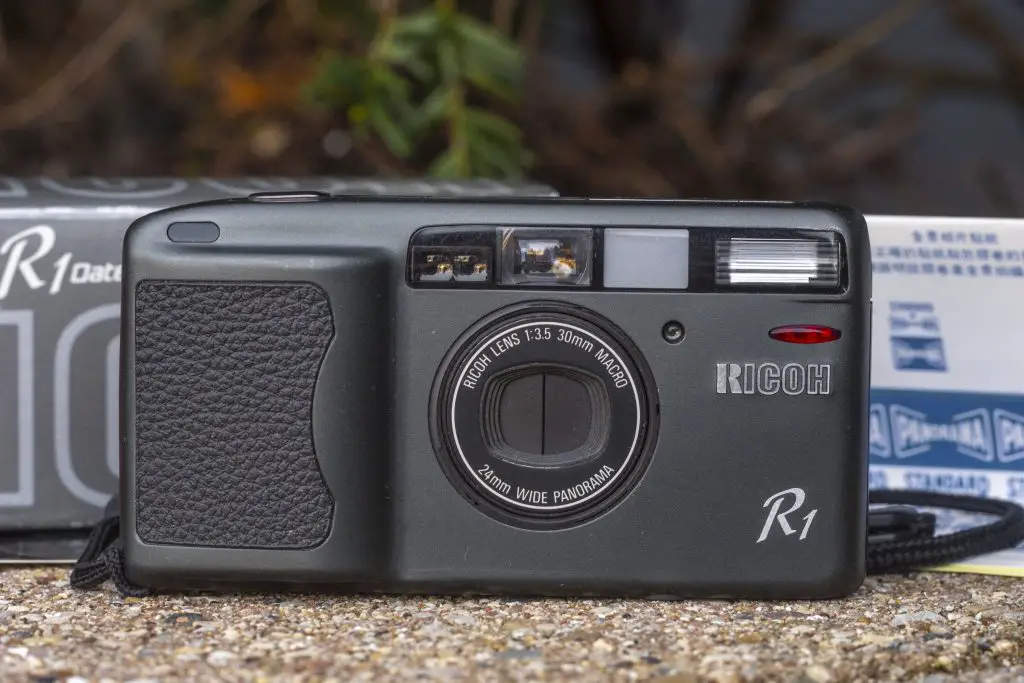






I bought an R1 at a camera swap in Rochester NY for $5 in 2007. It worked great for about a year or so, and I loved the images that I got from it. Then, it fell off the edge of my desk and never worked again!
That’s unfortunate that it fell, but there’s a very good chance that even if it never fell off your desk, it would have stopped working by now anyway! 🙂
Yeah, those all-electronic little 35s just don’t last. Pick up a Retina Ia and it ought to work almost as good as the day it was made. Plus, it can fall off a desk without a problem. Now, if some big celeb were to start using an Argus, the prices might rise. 😀
I had the same problem, film winding noise with no film in, no lcd display, until I put the film in. Then the lcd came to life and the camera worked. I wonder if your just needs a roll in it? Apologies if you tried that, I know it seems comically redundant, but I had the same experience initially. I hope your works, great little camera.